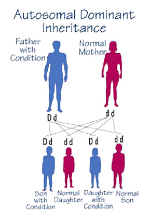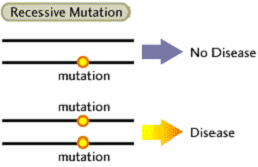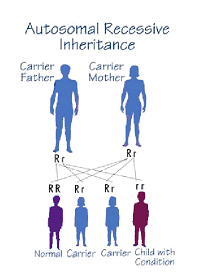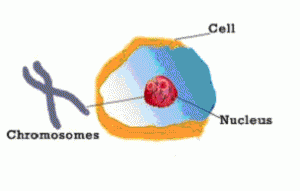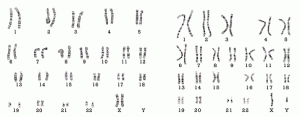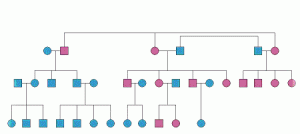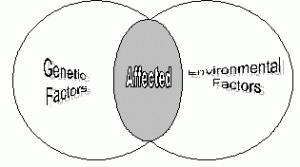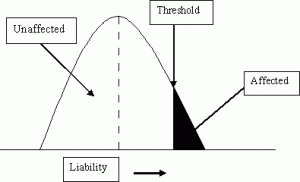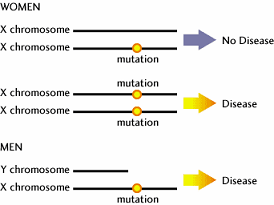Glossary
Affected family member
A family member who has the disease or medical condition in question.
Allele
Name for different forms of a gene. Different alleles of a gene may produce different forms of a protein. Some alleles of a gene may form altered proteins that do not function properly. These can often lead to disease.
Amino acid
Amino acids are small molecules that make up proteins. There are over 100 different amino acids, but our body uses only 20 amino acids to make all of its proteins. Our genes determine the sequence of amino acids in a protein. This sequence determines what shape the protein takes, and what function that protein serves in the body.
Autosomal dominant
A pattern of inheritance that involves genes that are located on autosomes which are chromosomes 1-22. Autosomes are non-sex chromosomes (sex chromosomes are the X and Y chromosomes) Although genes are always in pairs, in autosomal dominant inheritance, you only need to inherit one copy of a particular form of a gene in order to show that trait.
Autosomal recessive
A pattern of inheritance that involves genes that are located on autosomes (which are chromosomes 1-22). In autosomal recessive inheritance, you must inherit two copies of a particular form of a gene in order to show that trait. One example of an autosomal recessive pattern of inheritance is the disease PKU, which causes people to be unable to break down phenylalanine (an amino acid in protein) A person must inherit mutated copies of the PKU gene from both parents in order to develop the disease.
Autosome
One of the two types of chromosomes in most animals. Autosomes contain many thousands of genes, but do not contain genes that determine the sex of an organism. Sex chromosomes, on the other hand, do contain sex-determining genes. Humans have a total of 46 chromosomes; 44 autosomes (chromosomes 1–22)and two sex chromosomes (X and Y).
Base pair
Bases are the components that make up DNA. There are 4 bases: Adenine (A), Cytosine (C), Guanine (G), and Thymine (T). In a DNA molecule, the bases pair with each other to hold together the two strands in a double strand of DNA. A always pairs with T, and G always pairs with C. Base pairs are also used as a unit of measure to indicate a length of DNA. A piece of DNA that is 10bp long has 10 base pairs in it. Likewise, a gene that is 2Kb long has 2,000 base pairs. The human genome has around 3 billion base pairs.
Blood relative
Everyone in your family who is genetically related to you. Blood relatives DO NOT include step children, adopted individuals, and people who have married into the family.
Carrier
A person who has a gene mutation in one of their genes (remember genes come in pairs). hat can cause a disease, but does not have any symptoms of the disease themself. The mutation is often recessive, which means that both copies of the gene have to be mutated in order for disease symptoms to develop. Carriers are able to pass the mutation on to their children and therefore have an increased chance of having a child with the disease.
Cell
The smallest living unit. Cells make up all organs and tissues in multi-cellular organisms, like humans. They can also live independanty, as in bacteria and other microorganisms. At a minimum, a cell is surrounded by a membrane, contains DNA at some stage in its life, and is able to replicate itself into two equal parts.
Chromosome
A strand of DNA contained within a cell. Each chromosome contains many thousands of genes. In humans, there are a total of 46 chromosomes, half of which come from each parent. The autosomes come in pairs 1-22 for 44 total and humans also have two sex chromosomes – XX in females and XY in males. The combined total of all chromosomes in a cell is the genome. See Karyotype for diagram.
Chronic
Any condition that lasts for a long period of time or occurs frequently. For example, phenylketonuria and homocystinuria are both chronic conditions.
Clinical geneticist
A doctor who treats and diagnoses genetic conditions. May also known as a medical geneticist.
Clinical trial
Clinical trials test the effectiveness of new drugs or treatments. These studies determine how well the treatments work, what risks are associated with them, and whether they work better than the current treatment.
Close relative
A parent, sibling, child, aunt, uncle, niece, nephew, grandparent, or grandchild are all considered close relatives.
Deoxyribonucleic acid (DNA)
Deoxyribonucleic acid (DNA) is a molecule that makes up chromosomes. It is composed of four units (called bases) that are designated A, T, G, and C. The sequence of the bases spell out instructions for making all of the proteins in an organism. The instruction set for each individual protein is a gene. A change in one of the DNA letters making up a gene is a mutation. In some cases, these mutations can alter the protein instructions and lead to disease. Each individual passes their chromosomes on to their children, and therefore pass down the DNA instructions. It is these instructions that cause certain traits, such as eye or hair color, to be inherited.
Distant Relative
A relative who is not closely related to you. Distant relatives do not include parents, siblings, children, aunts, uncles, nieces, nephews, grandparents, and grandchildren. Great-aunts, cousins, and second cousins are examples of distant relatives.
DNA
Deoxyribonucleic acid (DNA) is a molecule that makes up chromosomes. It is composed of four units (called bases) that are designated A, T, G, and C. The sequence of the bases spell out instructions for making all of the proteins in an organism. The instruction set for each individual protein is a gene. A change in one of the DNA letters making up a gene is a mutation. In some cases, these mutations can alter the protein instructions and lead to disease. Each individual passes their chromosomes on to their children, and therefore pass down the DNA instructions. It is these instructions that cause certain traits, such as eye or hair color, to be inherited. See under deoxyribonucleic acid for diagram.
Genetic Screening
Screening is the process of testing for disease in a person who does not show signs of having the disease (a non-symptomatic or asymptomatic person). Screening is often done at the population level, such as with Newborn Metabolic Screening. The goal of screening is to identify the disease in its early stages and thus allow for treatment and preparation. It is important to note that, with most screening, follow up testing is required to confirm a diagnosis.
Below are the possible results of screening.
| Possible Result | True Positive | True Negative | False Positive | False Negative |
|---|---|---|---|---|
| Person’s Health Status | Person has the disease | Person does NOT have the disease | Person does NOT have the disease | Person has the disease |
| Test Results | Confirms that person has the disease | Confirms that person does not have the disease | Test results say that person HAS the disease | Test says that the person does NOT have the disease |
Genetic testing
There are many different types of genetic testing. Genetic testing is any laboratory test that can determine if an individual has an inherited disorder.
Enzyme
A molecule that helps chemical reactions take place. For example, enzymes in the stomach speed up the process of breaking down food. Each enzyme can participate in many chemical reactions without changing or being used up.
False negative
A test result indicating that a person does not have a specific disease when, in fact, they do have a specific disease.
False positive
A test result indicating that a person has a disease when, in fact, they do not have a disease.
Family medical history
Information about the medical conditions that affect your family members. Doctors can use your family medical history to determine what disease you may be at higher risk for developing, and to establish an appropriate screening schedule for your level of risk.
First degree relative
A relative who is a person’s biological mother, father, full sibling, or child. Step parents, step children, or half siblings are not first degree relatives.
Gene
A segment of DNA that contains the instructions to make a specific protein (or part of a protein). Genes are contained on chromosomes. Chromosomes, and the genes on those chromosomes, are passed on from parent to child. Errors in the DNA that make up a gene are called mutations and can lead to diseases.
Genetic
Relating to (or due to) genes and heredity or the field of studying genes and heredity.
Genetic code
The genetic code determines how the sequence of bases in a gene code for the sequence of amino acids in a protein. A gene is made of bases that are designated A, T, G, and C. Each series of three bases is essentially a word that codes for one of the 20 amino acids that make up all proteins. For example, the sequence AAG within a gene tells a cell to insert the amino acid lysine into a growing protein.
Genetic counselor
A healthcare professional who provides information and support to individuals and families who have a genetic disorder, might be at risk for developing an inherited condition, or are concerned that they may have a child with an inherited disease.
Genetic map
A map of where genes are located relative to each other on the chromosome. Genetic maps are also called linkage maps.
Genetic marker
An identifiable region of DNA that is at a known location on a chromosome. Genetic markers are used to help scientists locate where a gene is on a chromosome. Scientists who are looking for genes that cause a specific disease or trait can look at the DNA of family members with the disease and compare it with the DNA of family members without the disease. If they find that certain genetic markers are present in the group with the disease, then the scientists can narrow their search to the area surrounding that marker.
Geneticist
A person who specializes in genetics.
Genome
All of the genetic material (DNA) contained in a full set of chromosomes in an organism. In humans, about three billion base pairs make up our genome.
Genomic DNA
The DNA that is found in the nucleus of a cell. Most of our genes are contained in the genomic DNA. However, some genes are contained within tiny organs called mitochondria that are within cells. This is called mitochondrial DNA.
Hereditary
Something that is passed on from a parent to the child, usually through the genes.
Informed consent
Voluntarily agreeing to do something after receiving and understanding all of the relevant information. Participation in all medical trials requires informed consent.
Inherit
Acquiring a trait from one’s parents. Most traits, such as eye color or hair color, are inherited from a parent through genes. However, traits can be inherited through other biological mechanisms, such as through the womb, or through behaviors learned by living with the parents.
Karyotype
When chromosomes are studied in a laboratory, they are isolated from a cell and treated with special stains. These stains cause specific, identifying bands to become visible on each chromosome. The chromosomes are put into order by pair, size and shape to make an organized picture called a karyotype. A karyotype allows cytogeneticists (scientists who study chromosomes) to see whether a person has any extra or missing genetic material, or any large rearrangements in their chromosomes. A karyotype does not allow for changes in individual genes to be seen. The karyotype on the left is for a normal female (46, XX) and the karyotype on the right is for a normal male (46, XY).
Linked
Linked genes are found close together on the same chromosome, and are inherited together more often than would be expected by chance. In fact, the closer they are to each other, the more likely it is that they will be inherited together. Researchers take advantage of linkage to determine a person’s chance of developing a disease if the exact disease gene is unknown. To do this, they look at the DNA of people with the disease, and at the DNA of people who do not have the disease. They try to find certain genetic markers that are present more often in people who have the disease than in those who don’t. This tells researchers that the disease-causing gene is located close to that genetic marker. Although researchers cannot give a genetic test for the disease gene, they can test for the genetic marker. People who have the genetic marker are more likely to have also inherited the disease-causing gene than people who do not have the genetic marker.
Maternal
Having to do with the mother.
Maternal inheritance
A form of inheritance in which a trait is only inherited from the mother. Maternal inheritance may be due to substances present in the egg, in the womb, or in subcellular structures called mitochondria. Mitochondria contain some of their own DNA, mutations in which can cause disease. Because the sperm have no mitochondria, people get all of their mitochondria through the mother’s egg. If the mother has mitochondria with a disease-causing mutation, that disease can be passed on to the children. One example of a maternally inherited diseases is a form of diabetes call maternally inherited diabetes and deafness (MIDD).
Medical geneticist
A doctor who diagnoses genetic conditions.
Medical release form
A form that gives permission to get a person’s medical records. Medical release forms have to be signed by the person whose records you wish to access or by a close relative if that person is deceased.
Mitochondrial inheritance
The chromosomes in our body are contained in the nucleus. Mitochondria are structures located in the cytoplasm of the cell, outside the nucleus. They are organelles that provide much of the energy cells need for the work that they do. Mitochondria also contain genes that are separate from the ones in the nucleus. The mitochondrial DNA is arranged in one long circular string of genes rather than in chromosomes.
All of the mitochondria in a person’s cells descend from the mitochondria present in the original egg from that person’s conception. The sperm does not contribute any mitochondria to the fetus. Thus, a person’s mitochondria are only inherited from his or her mother. This pattern of inheritance is called mitochondrial or maternal inheritance. An abnormality in one of the mitochondrial genes can therefore be passed by the mother in her egg cells. Since mitochondria can be inherited only from a mother’s egg, mitochondrial genes show a very distinct pattern of inheritance: both males and females can be affected with a mitochondrial disease gene, but only females can transmit that mitochondrial disease gene to children.
Multifactorial Inheritance
Many conditions are caused by a combination of genes and other factors, such as the environment. These conditions are said to be “multifactorial”. People who have such a condition are often born into families with no other affected people. However, parents of a child with the condition have a greater chance of having another child with the condition than couples who do not have a child with the condition.
Mutifactorial inheritance is actually the most common form of inheritance; most traits and characteristics are inherited in a multifactorial fashion.
Threshold Model of Disease
The figure above shows that a certain combination of genetic and environmental factors is needed in order for a person to be affected with a multifactorial condition. The genetic and environmental factors add together and, when they reach the threshold level, cause a person to be affected.
Mutation
A change or alteration that occurs in the DNA. Mutations can be caused by the environment (sun, radiation, or chemicals), aging, or chance. Some mutations do not affect the information contained in the DNA. Other mutations have serious consequences on how that gene functions.
Nonsymptomatic
Not showing any of the signs of the condition or disease.
Pedigree
A medical drawing that includes all of a person’s close relatives, the relationship between family members, and health information. A pedigree is used by health care professionals to analyze a family for genetic diseases.
Polymorphism
A change in the DNA sequence (mutation) that is present in at least 1 percent of the population and is not considered harmful. One example of a polymorphism is in the hair color gene. Slight changes in the DNA sequences make the hair blond or brown.
Protein
A molecule that makes up many parts of every cell in the body. Examples of proteins include hormones, enzymes, hair, and antibodies. Proteins are made up of 20 different types of individual units called amino acids. It is the order of these amino acids in a protein that determines what form and function a protein has. Each gene holds the instructions for making a single protein.
Screening
The process of testing for disease in a person who does not show signs of having the disease (nonsymptomatic person). The goal of screening is to catch the disease in its early stages.
Sequencing
The process of determining the order of the bases in a region of DNA.
Sibling
A person who shares the same mother or father. A brother or sister who shares both parents is called a full sibling. A brother or sister who only shares one parent is called a half sibling.
Sporadic
Occurring occasionally or randomly. In medical terms, a sporadic disease is one in which the disease occurs in people with no family history and no inherited cause.
Surveillance
The process of monitoring or checking for signs or symptoms of a disease.
Susceptibility
The likelihood that a person will develop a condition or disease.
Syndrome
A group of symptoms and clinical findings that, when found together, make up a particular condition or disease.
Truncated
To be cut short or terminated early. In the case of a truncated protein, only the first part of the protein is made.
X chromosome
One of the two chromosomes that are responsible for determining the sex of an organism. The other sex chromosome is called the Y chromosome. Both the X and the Y chromosome contain several genes, only some of which are involved in determining sex. In humans, the X chromosome is the larger of the two sex chromosomes. Females usually have two X chromosomes and males usually have one X chromosome and one Y chromosome.
X-Linked
A mode of inheritance. X-linked genes are found on the X chromosome. They have a different inheritance pattern that other genes because women have two X chromosomes while men only have one. Any mutation on the X chromosome may not cause a disease in women if the gene on the other chromosome is normal. However, that same mutation on one X chromosome in men will cause the disease because they have no second copy of the gene to compensate.
Y chromosome
One of the two sex chromosomes that is responsible for determining the sex of an organism. The other sex chromosome is called the X chromosome. Both the X and the Y chromosome contain several genes, only some of which are involved in determining sex. In humans, the Y chromosome is the smaller of the two sex chromosomes. Most females have two X chromosomes and most males have one X chromosome and one Y chromosome.

